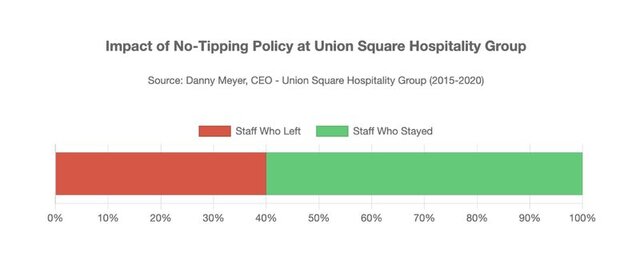
Tipping is often criticized, yet it remains the backbone of the restaurant industry. Despite debates over “tip fatigue” and occasional attempts to eliminate tipping, the practice persists, and for good reasons. Understanding why tipping endures can help operators create fair, transparent, and efficient systems that benefit staff, diners, and the business.
The “Hospitality Included” experiment, led by renowned restaurateur Danny Meyer, sought to eliminate tipping at Union Square Hospitality Group restaurants in 2015. The plan was simple: raise menu prices, pay staff consistent hourly wages, and close the pay gap between front-of-house and kitchen staff. Despite careful planning, the experiment ultimately failed and was reversed in 2020. Similar attempts across the industry have highlighted three key truths about why tipping continues to thrive.
1. Servers Don’t Want Lower, Predictable Wages
For many servers, tips make up a significant portion of income. While predictable wages might sound appealing, they often result in lower overall earnings, especially for top performers. When Meyer implemented his no-tipping policy, some servers lost as much as $10,000 annually. The restaurant group lost 40% of its front-of-house staff, as the best servers sought positions at competitors who retained tipping. Tips create a performance-based incentive that wages alone can’t replicate.

2. Diners Resist Higher Menu Prices
Even when diners understand that higher menu prices are intended to cover staff wages, resistance is common. Psychologically, a $28 entree feels more expensive than a $24 entree with a $5 tip, even if the total cost is similar or slightly higher in the no-tipping scenario. This pricing perception makes it challenging for restaurants to replace tipping with higher menu prices without affecting customer behavior.
3. The Tax System Favors Tipping
The U.S. tax system provides federal advantages for tips that wages do not. Switching from tips to higher wages can dramatically increase payroll taxes, sometimes tripling overnight. This surge in business costs creates a financial barrier for restaurants considering a no-tipping model.
See how Mario Padrino, owner of five Padrino’s Restaurants, has seen tipping play out in his business. He explains, “We know the numbers, when the tip credit is eliminated, it doesn’t mean servers make more. In fact, they often end up making less. Paying a higher hourly wage doesn’t always guarantee more take-home pay, which is why employees prefer to work at places that still offer tips." Watch the short video →
Tipping persists not just for financial reasons, but because it taps into human psychology. Customers enjoy rewarding good service, creating a sense of control and satisfaction. For staff, tips reward performance and foster motivation, allowing top servers to earn more based on effort. And for operators, tipping can reduce labor costs while incentivizing exceptional service.
While tipping has its complexities, TipHaus provides tools that make it manageable, fair, and transparent:
By leveraging these tools, operators can embrace tipping strategically, rewarding staff fairly, maintaining customer satisfaction, and ensuring operational efficiency. Tipping isn’t going away, but with the right system, it can work better than ever for everyone involved.
Ditch spreadsheets, bank runs, and tip disputes. Book a live demo to see how TipHaus automates tip management end-to-end and kick of your free trial today!